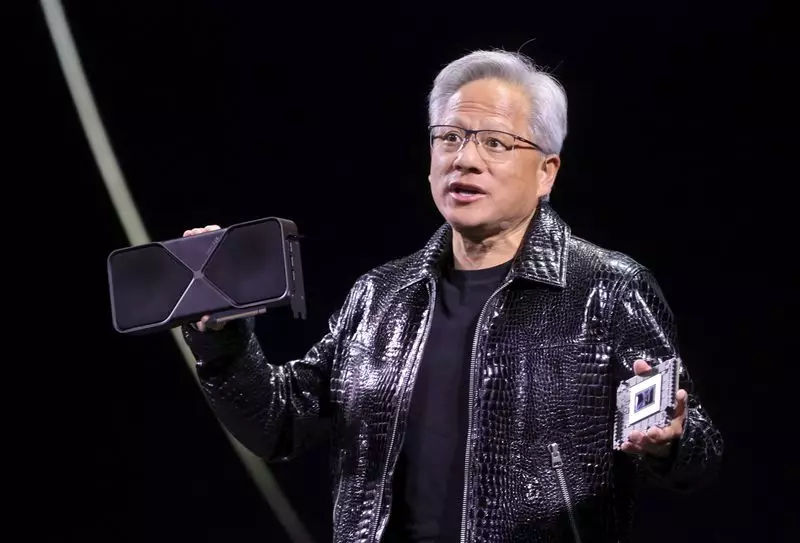As the world increasingly gravitates toward artificial intelligence and advanced computing technology, Nvidia’s recent announcements at the Consumer Electronics Show (CES) 2025 in Las Vegas are turning heads across multiple industries. The company unveiled groundbreaking products aimed at revolutionizing robotics, gaming, and even automotive automation, hinting at its ambitious vision of expanding into consumer tech beyond its core data center business.
A New Era in Robotics Training
One of the standout announcements from CEO Jensen Huang was the introduction of the Cosmos foundation models. These innovative models are designed to create synthetic training data, enabling robots and self-driving cars to learn and adapt at an unprecedented pace. Instead of the traditional, costly methods of data collection—such as employing humans to train robots or deploying fleets of vehicles to gather footage—Cosmos allows users to input simple text descriptions that translate into realistic video simulations. This advancement aims to reduce the financial burden associated with machine learning, while enhancing the accuracy with which machines can interpret their environments.
Huang’s assertion that this technology could be transformative for robotics echoes a broader trend in AI development where the focus is gradually shifting towards cost-effective solutions. However, skepticism remains. Industry analysts, including Vivek Arya from Bank of America, have pointed out that despite the promise of synthetic data, delivering reliable and affordable products remains a challenge. This raises questions about the scalability of these innovations—will the robotics sector follow through or remain just an intriguing standpoint, similar to the nascent phases of the metaverse and autonomous vehicles?
Concurrently, Nvidia showcased its latest RTX 50 series gaming chips, leveraging the proprietary ‘Blackwell’ AI technology that has significantly boosted the company’s data center revenues. These chips are designed to elevate video gaming experiences to unprecedented levels by providing lifelike graphics, particularly in areas critical to gamers, such as ‘shaders.’ With pricing ranging from $549 to $1,999, these chips promise not only enhanced visual fidelity but also efficiencies for game developers striving to render more realistic human features.
The gaming community often thrives on technological advancements, and Nvidia’s efforts to cater to this market can potentially catalyze an uptick in sales as gaming becomes more visually sophisticated. Experts like Ben Bajarin of Creative Strategies echo this sentiment, suggesting that the immediate future looks promising for Nvidia’s financial performance, largely due to these gaming innovations.
Perhaps one of the most striking products unveiled was Project DIGITS, Nvidia’s first foray into desktop computers geared specifically for programmers. This $3,000 machine is aimed at software developers looking to test and develop AI systems swiftly. By incorporating features from their high-performance data center offerings, it allows for a more compact yet powerful setup. Such a calculated move indicates Nvidia’s recognition of a burgeoning market among developers who require specialized hardware to push the boundaries of AI innovation.
Unlike mainstream consumer desktops, Project DIGITS emphasizes functionality for a niche audience. This may resonate well within tech circles but could be a limiting factor when considering market penetration among average consumers who may prioritize versatility and affordability.
Nvidia also announced a partnership with Toyota to incorporate its advanced Orin chips in several vehicle models, enhancing driver assistance technologies. This partnership highlights the increasing importance of software and AI integration in the automotive industry and supports Huang’s projection of reaching $5 billion in automotive-related revenues by fiscal 2026.
Such collaborations could solidify Nvidia’s standing in the automotive sector as a powerhouse in advanced driver assistance systems, especially amid the global race toward fully autonomous vehicles. However, the details about the vehicles utilizing these technologies remain sparse, leaving potential customers and investors eager for clarifications that could affect stock performance and market perceptions.
The announcements at CES 2025 position Nvidia not merely as a leader in AI and graphics processing but as a formidable innovator unafraid to venture into new territories. With its stock reaching new heights and its valuation on an upward trajectory, the company appears poised to set new benchmarks across various sectors. However, in pursuing these ambitious avenues, it must address potential pitfalls related to reliability and consumer adoption, ensuring that its innovations translate into widespread usability and financial success.
As the tech landscape evolves, Nvidia’s upcoming ventures could lead to monumental shifts in how industries approach automation, gaming, and consumer computing. Only time will reveal if these innovations will unlock vast new markets or remain niche endeavors, but anticipation is high, and the stakes are greater than ever.

